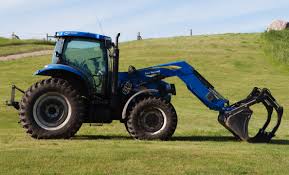 Print a Sign-In Sheet | Spanish Version
Print a Sign-In Sheet | Spanish Version
Overturns
According to the National Institute for Occupational Safety and Health (NIOSH), tractor overturns are the leading cause of fatalities in the agriculture industry, resulting in approximately 20 deaths per 100,000 workers. The majority of tractor overturn incidents take place when these farm vehicles turn on their side or tip over backward. These overturns occur quickly (often in seconds), which leaves the operator little or no chance to get clear as the tractor tips or rolls.
Tractors are generally safe when operated properly. Tractors that are old, in poor condition, lack safety guards and devices, or are driven in an irregular or risky manner can contribute significantly to unsafe or hazardous conditions.
Employers must ensure that tractor operators receive initial and at least annual training on the safe operating practices described below:
- Fasten seat belts securely (for tractors with rollover protection).
- Avoid operating the tractor near ditches, embankments, and holes whenever possible.
- Stay off slopes too steep for safe operation.
- Reduce speed when turning or crossing slopes and on rough, slick, or muddy surfaces.
- Operate the tractor smoothly and avoid jerky turns, abrupt starts, or sudden stops.
- Be attentive, especially at row ends, on roads, and around trees
Rollover Protective Structures (ROPS)
An operator’s chances of surviving a tractor overturn without a serious injury are very good if the tractor has a rollover protective structure (ROPS) and the operator is wearing a seat belt. A ROPS is a roll bar or cage frame that is designed to form a zone of protection around the operator if a tractor overturns. However, to prevent being thrown from the equipment, the operator’s seat belt must also be in use.
Power Take-Off (PTO) Shafts
A PTO shaft allows farmworkers to use power from the tractor’s engine to drive a variety of machines and implements. PTOs are useful but they can pose serious safety hazards. Employers must educate workers on avoiding contact with a rotating PTO and they must inspect the PTO shaft to ensure that the PTO guard is always in place. Employers should replace missing or damaged PTO guards immediately.
At the time of initial assignment and at least annually thereafter, the employer should train every farmworker in the safe operation and servicing of all equipment with which the operator will be involved, including the following safe operating practices:
- All PTOs, including rear, mid- or side-mounted shafts, shall be guarded either by a master shield or other protective guarding.
- Before servicing, adjusting, cleaning, or unclogging the equipment, stop the engine, disconnect the power source, and wait for the PTO shaft to stop, except when the machine must be running to be properly serviced or maintained. In that case, the employer must train workers on all steps and procedures needed to safely service or maintain the equipment.
- Keep all guards in place when the machine is in operation.
- Ensure that everyone nearby is clear of the machine before starting the tractor’s engine and engaging the PTO shaft’s selector switch. Tie back and tuck in long hair and do not wear loose clothing. A rotating PTO shaft can catch hair or clothing.
- If possible, avoid working alone around PTO-driven machinery. If entanglement occurs, a co-worker may be able to stop the PTO shaft in time to prevent more serious injury or death.
Emergency Planning and Preparedness
Many injuries in agriculture occur far from hospitals and emergency medical facilities. Moreover, many employers do not have the training or capability to treat these injuries. Because treatment facilities are not typically located within a reasonable distance or timeframe, employers should:
- Develop an emergency action plan that addresses all likely hazards.
- Designate an emergency staging area for the field or office.
- Train tractor operators on how to respond to emergency situations.
- Ensure that each tractor has a first-aid kit and working fire extinguisher.
- Assemble a first-aid kit that is designed to address agricultural injuries and incidents. Agricultural first-aid kits should contain basic medical items, such as gauze, splints, ice packs, surgical tape, disposable gloves, eye patches, burn dressings, and a first-aid instruction booklet.
- Call local first responders or 911 in case of an emergency. When reporting an emergency, provide your name, location, the nature of the emergency, and where the worker(s) can be reached.
- Maintain frequent communication with tractor operators who work alone or in remote areas
KEMI does not assume liability for the content of information contained herein. Safety and health remain your responsibility. This information is to be used for informational purposes only and not intended to be exhaustive or a substitute for proper training, supervision, or manufacturers’ instructions/recommendations. KEMI, by publication of this information, does not assume liability for damage or injury arising from reliance upon it. Compliance with this information is not a guarantee or warranty that you will be in conformity with any laws or regulations nor does it ensure the absolute safety of any person, place, or object, including, but not limited to, you, your occupation, employees, customers, or place of business.

